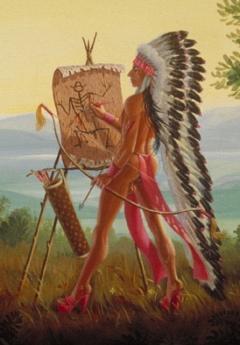We’ve all seen romantic representations of the Old West: those lush imaginings of early colonists depicting flowing plains, or stereotypical portraits of aboriginals in their headdresses looking exotic and inscrutable. But what if roles were reversed and the narrative of the Old West had been told by a cunning two-spirited crossdresser?
Step into Miss Chief Eagle Testickle’s travelling gallery and she will tell you all about “the European male in his original state.” Referring to European men as “fine specimens” and to herself as “their historian,” Miss Chief Eagle Testickle deems herself “authorized” to make conclusions about their character. Sound familiar?
The Triumph of Mischief, currently on display at the Glenbow Museum in Calgary, is internationally acclaimed Toronto artist Kent Monkman’s reimagining of the Old West. And what a reimagining it is: in Monkman’s fantastic version, European explorers are seduced by Miss Chief Eagle Testickle — who can sometimes be found wearing a dream-catcher bra, a raccoon jock strap and seven-inch platform shoes.
And why not? If 19th-century artists like George Catlin and Paul Kane — both of whom were famous for their depictions of Aboriginal people — can create (mis)representations of historic European-Indian relations and Aboriginal culture, Monkman can draw on his Aboriginal and queer perspective to recreate another version of so-called “reality.” And that’s the point, he says.
“Of course, I’m using a liberal dose of my own imagination,” says Monkman, “but I’m doing that to also talk about how much they (19th century artists like Catlin, Kane and Albert Bierstadt) used their own artistic sense in creating their work.”
Miss Chief Eagle Testickle — Monkman’s alter ego — is the star of this multimedia exhibit, including oil paintings, sculptures, video and photography. Monkman describes Miss Chief as empowered, dynamic, self-aggrandizing, trickster, time-traveller, flamboyant, gay, crossdresser, two-spirited and a fan of Louis Vuitton. Her favourite colour is hot pink.
“Miss Chief” is a pun for mischief, representing her naughty character, and “Eagle Testickle” is a play on the word egotistical. Miss Chief’s presence in Monkman’s art parodies the fact that artists Catlin and Kane painted themselves into their work.
“That influenced how they depicted their subjects,” says Monkman, referring to Catlin and Kane as egomaniacs. Monkman’s own work explores the power dynamic between artist and subject. In one of Monkman’s paintings, titled “Si je t’aime prends garde à toi” (“If I love you beware”), a sculptor embraces his creation, and it comes to life.
Monkman creates new narratives and mythologies about the Old West by using historic iconography. He inserts colourful characters engaged in mischief and homoerotic activities onto historic paintings, like those created by 19th-century artist Albert Bierstadt. Bierstadt painted vast immaculate landscapes, imbued with Christian ideology, depicting the frontier as the Promised Land. By portraying the Old West as untapped territory, Bierstadt’s paintings, which were void of people, erased the presence of Aboriginal culture, says Monkman.
Monkman alters this romantic representation by copying Bierstadt’s landscapes and using them as backdrops for his own paintings, but instead of being empty, Monkman populates the pristine scenery with diverse beings, including everything from coyotes to half-men/half-beasts, shamans, artists, European explorers, traders and, of course, Miss Chief. She can even be found rising from a body of water, draped in hot-pink fabric while artists, explorers and traders observe the Christlike apparition.
“It’s really about getting people to think about the fact that these landscapes were not empty as they were painted in the 19th century,” says Monkman. “They were actually populated by many different nations of people.”
Monkman’s work might be considered controversial to some, especially in Alberta, where traditional images of the Old West are held near and dear to the heart, but Monkman hopes it helps Albertans see historic representations of colonization under a new light.
“I hope [people] just enjoy the richness of the paintings and the films, and that they will look differently at some of the historical work at the collection here in the Glenbow, and maybe think about some of the narratives that maybe weren’t so obvious in those historical works,” he says.
The Triumph of Mischief is on display at Calgary’s Glenbow Museum until April 25.

 Why you can trust Xtra
Why you can trust Xtra


